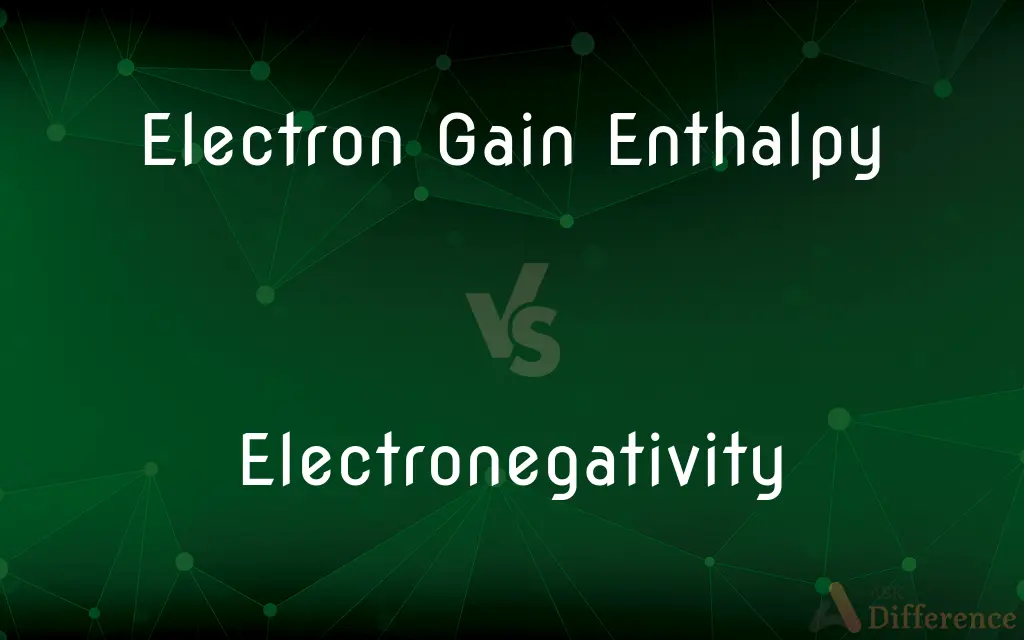Electron Gain Enthalpy vs. Electronegativity — What's the Difference?
Edited by Tayyaba Rehman — By Fiza Rafique — Published on December 4, 2023
Electron Gain Enthalpy measures energy change during electron addition to an atom; Electronegativity indicates an atom's ability to attract shared electrons.

Difference Between Electron Gain Enthalpy and Electronegativity
Table of Contents
ADVERTISEMENT
Key Differences
Electron Gain Enthalpy refers to the energy change observed when an electron is added to a neutral atom in its gaseous state. It quantitatively evaluates how much energy is released or absorbed when this addition process occurs, offering insights into the atom's willingness to accept an electron.
Conversely, Electronegativity is a qualitative measure, reflecting the tendency of an atom to attract shared electrons in a chemical bond. A higher electronegativity value suggests that the atom has a stronger pull for electron pairs compared to atoms with a lower electronegativity value.
When considering Electron Gain Enthalpy, it's crucial to note that a more negative value suggests the atom releases energy upon gaining an electron, making it more favorable for the atom to acquire an electron. However, this does not necessarily mean the atom has a high electronegativity.
In the case of Electronegativity, this measure can guide predictions about bond polarity. Atoms with significantly differing electronegativities tend to form polar bonds. But Electronegativity does not provide specifics about energy changes, as Electron Gain Enthalpy does.
To illustrate, chlorine possesses a high Electron Gain Enthalpy and a high Electronegativity. It means chlorine not only releases energy when gaining an electron but also strongly attracts shared electrons in chemical bonds.
ADVERTISEMENT
Comparison Chart
Definition
Energy change on electron addition to an atom.
Atom's ability to attract shared electrons.
Nature
Quantitative.
Qualitative.
Application
Predicts energy changes in electron addition.
Indicates bond polarity and type.
Associated Values
Positive or negative energy values.
Scale values (e.g., Pauling scale).
Relativity to Electron Attraction
Not always indicative of electron attraction.
Directly related to strength of electron pull.
Compare with Definitions
Electron Gain Enthalpy
Reflects atom's stability post-electron addition.
Atoms that become more stable have a more negative Electron Gain Enthalpy.
Electronegativity
Indicates bond polarity.
The difference in Electronegativity between hydrogen and oxygen results in a polar bond in water.
Electron Gain Enthalpy
Measures atom's willingness to accept an electron.
A highly negative Electron Gain Enthalpy suggests the atom easily accepts electrons.
Electronegativity
Qualitative measure of electron pull.
Electronegativity values guide predictions about how atoms behave in bonds.
Electron Gain Enthalpy
Energy change during electron addition.
Chlorine's negative Electron Gain Enthalpy indicates energy release upon electron addition.
Electronegativity
Varies across the periodic table.
Electronegativity generally increases across a period and decreases down a group.
Electron Gain Enthalpy
Can be endothermic or exothermic.
Noble gases often have positive Electron Gain Enthalpy values, indicating energy absorption.
Electronegativity
Utilizes scales like Pauling for quantification.
On the Pauling scale, fluorine has the highest Electronegativity of 3.98.
Electron Gain Enthalpy
Directly tied to atomic structure and configuration.
Due to its electron configuration, nitrogen has a positive Electron Gain Enthalpy.
Electronegativity
Atom's ability to attract shared electrons.
Fluorine's high Electronegativity makes it the most electronegative element.
Electronegativity
(chemistry) The tendency, or a measure of the ability, of an atom or molecule to attract electrons when forming bonds.
Electronegativity
(chemistry) the tendency of an atom or radical to attract electrons in the formation of an ionic bond
Common Curiosities
Can Electron Gain Enthalpy be positive?
Yes, some atoms absorb energy when an electron is added, indicating a positive value.
What is Electron Gain Enthalpy?
Electron Gain Enthalpy is the energy change when an electron is added to a neutral atom in its gaseous state.
How does Electronegativity differ?
Electronegativity measures the atom's ability to attract shared electrons in a bond.
Does a negative Electron Gain Enthalpy always indicate high Electronegativity?
No, while related, they are distinct concepts, and one doesn't always imply the other.
Why do atoms with high Electronegativity form polar bonds?
Because they have a strong pull on shared electrons, creating an uneven electron distribution.
Why is Electron Gain Enthalpy important in chemistry?
It provides insights into atomic and ionic stability and can predict certain chemical behaviors.
Does higher Electronegativity mean an atom is more reactive?
Not necessarily. While it indicates a strong pull for electrons, other factors also influence reactivity.
Which element has the highest Electronegativity?
Fluorine is the most electronegative element.
How does Electronegativity vary on the periodic table?
It generally increases across a period (left to right) and decreases down a group.
Can an atom have both high Electron Gain Enthalpy and Electronegativity?
Yes, like chlorine, which releases energy when gaining an electron and also attracts shared electrons strongly.
How is Electron Gain Enthalpy related to atomic structure?
Electron configuration and atomic size influence an atom's willingness to accept an electron, affecting its Electron Gain Enthalpy.
Is Electronegativity always a fixed value for an element?
Generally, it's consistent, but can slightly vary based on the specific environment or bond.
How are Electron Gain Enthalpy values experimentally determined?
Through methods like electron affinity measurements in gaseous atoms.
What unit is Electron Gain Enthalpy measured in?
Typically, it's measured in kilojoules per mole (kJ/mol).
Share Your Discovery

Previous Comparison
Monoprotic Acid vs. Diprotic Acid
Next Comparison
Areolar Tissue vs. Adipose TissueAuthor Spotlight
Written by
Fiza RafiqueFiza Rafique is a skilled content writer at AskDifference.com, where she meticulously refines and enhances written pieces. Drawing from her vast editorial expertise, Fiza ensures clarity, accuracy, and precision in every article. Passionate about language, she continually seeks to elevate the quality of content for readers worldwide.
Edited by
Tayyaba RehmanTayyaba Rehman is a distinguished writer, currently serving as a primary contributor to askdifference.com. As a researcher in semantics and etymology, Tayyaba's passion for the complexity of languages and their distinctions has found a perfect home on the platform. Tayyaba delves into the intricacies of language, distinguishing between commonly confused words and phrases, thereby providing clarity for readers worldwide.
















































